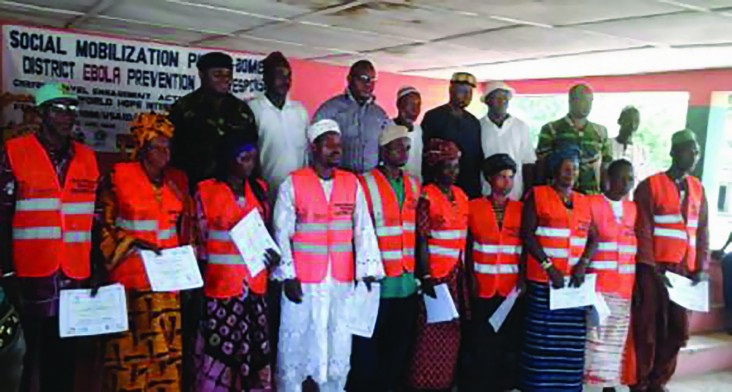- Work With USAID
- How to Work with USAID
- Organizations That Work With USAID
- Find a Funding Opportunity
- Resources for Partners
- Careers
- Get Involved
Speeches Shim

Background
The practice of burying loved ones is sacred in Sierra Leone. Many consider burials as farewell ceremonies where traditional heads and family members must be directly involved for the deceased to gain eternal life in the afterlife. During the Ebola outbreak, the act of touching corpses containing the virus, performed as a sign of respect, was a key contributor to the spread of the disease to family and community members.
World Hope International’s (WHI) project aimed to prevent the spread of Ebola Virus Disease (EVD) and support safe, dignified burials of all persons who died in the 13 chiefdoms of Bombali District. The work involved leading a team of 188 social mobilizers to engage in mass media radio discussions, and executing Ebola prevention and response messages in line with government strategies.
The social mobilization work led to the design and implementation of the innovative Cultural Burial Liaison initiative. The initiative was co-designed by Paramount Chiefs, Sierra Leone’s traditional leaders and cultural societal heads, to ensure the burial practices honored religious tradition.
Cultural Burial Liaisons (CBLs) trained ceremonial burial teams to address the problem of unsafe burials and ensure religious and cultural traditions could be maintained during safe burials. WHI began with community sensitization throughout Bombali District in Sierra Leone, then selected and trained 130 CBLs (one team per chiefdom), to support the District’s Burial Management team at the grassroots level. CBLs were identified by religious and traditional leaders as people who would be able to educate others about safe burial practices.
CBLs were also trained to serve as social mobilizers, which involved identifying and reporting cases of sick people, alerting the authorities of deaths, and ensuring no secret and/or unsafe burial took place.
Faith-Based and Community Initiatives
WHI spread Ebola prevention messages using person-to-person outreach at several events. The religious leaders/cultural liaisons were essential for the promotion of information. Faith leaders collaborated to present messages during service, ensuring that all members of their community knew how to keep themselves and their families safe. Through the involvement of traditional heads of cultural societies in the design of a safe burial practice in the era of Ebola, WHI ensured dignified medical burials, with adherence to the Infection Protection Control Standard Operating Procedures for burial, while performing cultural rites without risk of spreading the EVD infection. This approach enhanced confidence within the population that cultural traditions and safety precautions are not in conflict with each other.
Winning the trust and confidence of communities played a central role in the rapid control of an out-break. The CBLs collaborated with Islamic, Christian and Traditional faith practices, which demonstrated that the particular faith was less central than the role each faith leader played in disseminating life-saving information.
Results
Thirteen Paramount chiefs, 136 section and 958 cultural societal members were engaged in a consultative dialogue which raised their awareness of the importance for safe dignified medical burials within the EVD period. In partnership with 130 CBLs to conduct 330 community engagement Ebola sensitiza-tion meetings in all 13 districts, each district was able to hear more about preventing Ebola. There were 403,004 (207,233 males; 195,771 females) attendees at Ebola prevention engagement activities, with some individuals participating more than once. In total, 2,193 people were given cultural and faith sensitive burials with help from the project.
Conclusion
One of the most lessons learned through this project is that every member of society needs to be involved to help eradicate Ebola. WHI found that voluntary behavior change came from: 1) providing Sierra Leoneans with the opportunity to understand the behaviors that contribute to the spread of Ebola while offering an alternative course of action; 2) giving them responsibilities to fight the disease in their own group and, most importantly; 3) acknowledging the positive impact traditions may have.
Behavior change also came more easily when messages were brought to communities by their own people. Additionally, since the project engaged local leaders, Ebola messages were communicated in every local dialect. Another key takeaway from the project is the critical role religious communities can play in supporting life-saving behaviors.

Comment
Make a general inquiry or suggest an improvement.